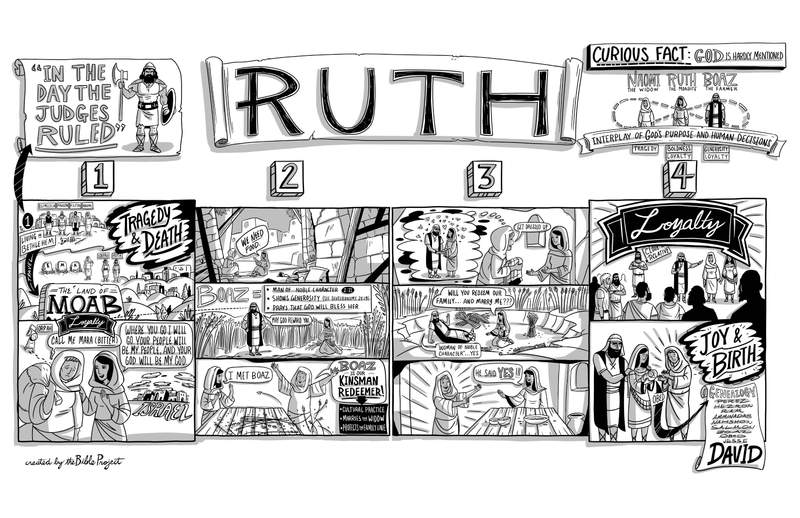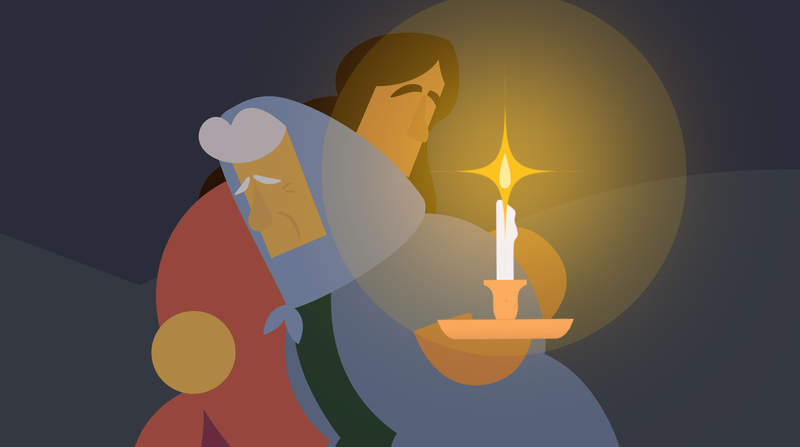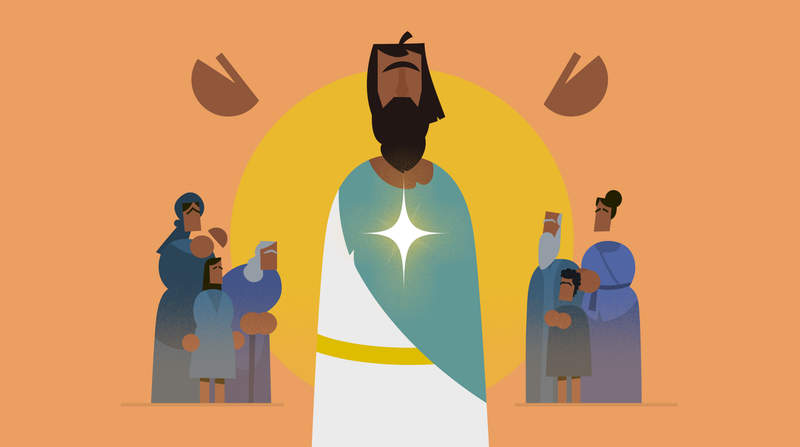The Book of Ruth
About

This short story is a brilliant work of theological art that invites us to reflect on the question of how God is involved in the day-to-day joys and hardships of our lives. There are three main characters in this book: Naomi the widow, Ruth the Moabite, and Boaz the Israelite farmer. Their story is told in four chapters that are beautifully designed. Let's dive in and see what unfolds.
Ruth 1: Introducing Naomi and Ruth
Chapter 1 opens with the line, “In the day when the judges ruled” (Ruth 1:1). This reminds us of the dark and difficult days from the book of Judges. We find an Israelite family in Bethlehem—Elimelech, Naomi, and their sons, Mahlon and Kilyon—struggling to survive through a famine. In search of food, they move into the land of Moab, Israel’s ancient enemy.
There, the father, Elimelech, dies, and the sons marry Moabite women, Ruth and Orpah. The sons soon follow after their father and die as well, leaving only Naomi and her daughters-in-law. With no reason to stay, Naomi tells them that she’s moving back home. She knows the life of an unmarried, foreign widow in Israel is going to be hard, so she compels them to stay behind. Orpah agrees, but Ruth shows remarkable loyalty to Naomi saying, “Where you go, I will go. Your people will be my people, and your God will be my God.” (Ruth 1:16) The two of them return to Israel, and the chapter concludes with Naomi changing her name to Mara, which means “bitter,” as she laments her tragic fate.

Ruth 2: Ruth Meets Boaz
Chapter 2 begins with Naomi and Ruth discussing where to find food, and it just so happens to be the beginning of the barley harvest. Ruth goes out and happens to end up picking grain in the field of Naomi’s relative, Boaz, who we’re told is a “man of noble character.” He notices Ruth and, after finding out about her story, shows remarkable generosity. He makes special provisions for the immigrant Ruth to gather in his field, just as the Torah commands (Deut. 24:19). Boaz is so impressed by Ruth’s loyalty to Naomi that he prays God will reward her for her boldness. After Ruth comes home that day, Naomi finds out that she met Boaz, and she’s thrilled. Boaz is their “family redeemer.” This phrase refers to a cultural practice in Israel where if a man in the family died and left behind a wife, it was the redeemer’s responsibility to marry the widow and protect the family. Naomi begins to hope that perhaps there is still a future for her family.
Ruth 3: Ruth Asks Boaz to Marry Her
Chapter 3 starts with Naomi and Ruth making a plan to get Boaz to notice their situation. Ruth will stop wearing the clothes of a grieving widow and show that she’s available to be married again. Ruth goes to meet Boaz on the farm at night. As she approaches, Boaz wakes up, startled, but Ruth makes her intentions clear, asking if Boaz will redeem the family and marry her. Boaz is once again amazed by Ruth’s loyalty to Naomi and her family and calls Ruth a “woman of noble character.” He tells her to wait until the next day, when he will redeem Ruth and Naomi legally before the town elders. Ruth returns to Naomi where they marvel together at the night’s events.
Ruth 4: Conclusion and the Role of God in the Story
In chapter 4, it all comes together. It turns out that there is a closer family member than Boaz who is also interested in redeeming the family, but, at the last minute, he finds out he has to marry Ruth the Moabite and declines. Boaz, on the other hand, knows Ruth’s true character, and he acquires the family property of Naomi’s husband and marries Ruth. Just as Ruth was loyal to Naomi’s family, so too was Boaz loyal to their family.
The story concludes with a total reversal of all the tragedies from chapter 1. The deaths of sons and husbands are reversed as Ruth is married again and gives birth to a new son, granting joy to her and Naomi. This symmetry becomes even more remarkable. The opening tragedy followed by a great act of loyalty on the part of Ruth is matched by Boaz’s act of loyalty that leads to the family’s final restoration. All this highlights the design of the internal chapters as well. Each begins with Naomi and Ruth making a plan for their future, followed by a providential meeting between Ruth and Boaz, concluded by Naomi and Ruth rejoicing at what has taken place.
The story is beautifully written, and this literary design actually connects with an interesting feature of the story: how little God is mentioned. The characters talk about God a few times, but the narrator hardly ever mentions God explicitly doing anything in the story. This is its subtle brilliance because God’s providence is at work behind every scene, weaving together the lives of the characters. While Naomi’s tragedy leads her to think that God is punishing her, we discover he’s actually on a mission to restore her. And God accomplishes that restoration through Ruth’s boldness and loyalty. The reason why Ruth’s actions bring healing to her and Naomi’s life is because of Boaz, a no-nonsense farmer who is full of generosity and loyalty.

The story is a literary exploration of the interplay between God’s purposes and human decisions. God weaves together the faithful obedience of his people to bring about his redemptive purposes.
This leads into the actual end of the book, which is not a story. The book concludes with a genealogy that shows how Boaz and Ruth’s son, Obed, was the grandfather of King David, from whom came the lineage of the Messiah. All of a sudden, the seemingly mundane events in this story are woven into God’s grand story of redemption for the whole world. The small story of Ruth is taken up in the larger story of God’s purpose, and in this way, the book of Ruth invites us to consider how God might be at work in our own lives as well.
Frequently Asked Questions
Here are some of the most common questions people ask online about this book.
God blesses Naomi primarily through people, especially the loyal love of Ruth, the kindness of Boaz, and the legacy of her grandson Obed. Naomi’s story begins tragically. After leaving Israel’s promised land to seek refuge in Moab during a time of famine, her husband and two sons die, leaving Naomi and her two Moabite daughters-in-law alone in a culture where widows are especially vulnerable.
When Naomi hears that God has provided food in her hometown of Bethlehem, she decides to return. She tells her daughters-in-law, Ruth and Orpah, to leave her and remain in Moab. But Ruth clings to Naomi, promising to remain faithful to her even in death and calling on God as a witness (Ruth 1:6-18).
God blesses Naomi through Ruth, who demonstrates “loyal love” (Hebrew: khesed, Ruth 3:10) by going back to Bethlehem with Naomi—despite Ruth’s outcast status as a poor Moabite widow—and by working in the barley fields to provide for them both.
God also blesses Naomi through the kindness of a landowner named Boaz. Boaz takes special notice of Ruth when she gleans in his fields, giving her extra food (Ruth 2). As one of Naomi’s “kinsman-redeemers” (go’el, see Lev. 25:25), Boaz restores Naomi’s family land (Ruth 4:1-9). He also fulfills the practice of levirate marriage by marrying Ruth to produce an heir for her deceased husband and continue Naomi’s family line (Ruth 4:10-13; see Deut. 25:5-10).
At the end of the story, God blesses Naomi through Ruth and Boaz’ child, Obed (Ruth 4:13-17). Naomi becomes his nurse, and the women of the town even claim him as Naomi’s own son, saying that he will be a “restorer of life” to her (Ruth 4:15, BibleProject Translation).
Naomi’s name comes from a Hebrew word that means “pleasant” (see Prov. 3:17). But when Naomi returns to her hometown after the death of her husband and sons in Moab, she asks the townswomen to instead call her Mara, meaning “bitter” (Ruth 1:20; see Exod. 15:23). She explains that God “has dealt very bitterly (Hebrew: marar)” with her by bringing her back to her land “empty” (Ruth 1:20-21, NASB).
Naomi’s lament, born out of intense suffering, is understandable. But what she can’t yet see is that God has not brought her back empty. God has given her Ruth, a Moabite daughter-in-law who makes an oath to remain faithful to Naomi even in death and calls on God as a witness (Ruth 1:16-17).
The rest of the story is about how God works to show his loyal love to Naomi through Ruth, leading the townswomen to declare that Ruth is better to Naomi than seven sons (Ruth 4:15). The book closes with Naomi’s arms full as she holds Ruth’s child—her grandson—who will restore her life from its bitter state (Ruth 4:15-16).
God blesses Ruth by working behind the scenes to provide security for her and her mother-in-law, Naomi. God works first through what seems like a chance encounter. When Ruth takes advantage of Israelite laws allowing her to glean what is left over in the fields after the harvesters (see Lev. 23:22; Deut. 24:19), it says that she “happened” to work in a field belonging to Boaz, a relative of Naomi’s deceased husband (Ruth 2:3, NASB). But the biblical author wants us to recognize that this is more than just mere coincidence—God has guided Ruth to Boaz’ field.
God also blesses Ruth through Boaz’ kindness and generosity. Boaz admires Ruth’s “loyal love” (Hebrew: khesed) to her mother-in-law and invokes God’s blessing on her (Ruth 2:10-12; Ruth 3:10). Treating her with dignity and compassion, he provides for her needs and offers her protection in his fields (Ruth 2:8-16). And when Ruth follows Naomi’s risky plan to secure a marriage to Boaz, Boaz agrees, offering her security and provision (Ruth 3:1-13; Ruth 4:9-10).
Finally, God blesses Ruth with a son in order to continue the family legacy. And her son Obed becomes the grandfather of King David (Ruth 4:17) and ancestor of Jesus of Nazareth (Matt. 1:5).
Boaz is a relative of Naomi’s deceased husband Elimelech, who is described as “a mighty man of strength (Hebrew: khayil)” (Ruth 2:1, BibleProject Translation). The Hebrew word khayil can refer to different kinds of strength, and here it may suggest that Boaz is a man with resources—in other words, that he has strength of possessions or wealth (see the NASB).
But when Boaz describes Ruth, who is poverty-stricken, as a “woman of strength (’eshet khayil)” (Ruth 3:11, BibleProject Translation; see Prov. 31:10), he’s talking about her strength of character. And since Boaz’ faithfulness and loyal love parallel Ruth’s, the reference to his khayil may also highlight the strength of his good character (see Ruth 2:1, CSB).
Boaz demonstrates his faithfulness to God by following God’s torah (“law” or “instruction”) and allowing Ruth to glean in his fields (see Lev. 23:22; Deut. 24:19). And he even goes beyond the demands of the law by giving her food, water, and protection and instructing his workers to pull some barley stalks from their own sheaves to leave for her (Ruth 2:8-16).
As a family relative, Boaz also fulfills his role as a “kinsman-redeemer” (go’el, see Lev. 25:25) by restoring Naomi’s family land (Ruth 4:1-9). And he agrees to marry Ruth, offering security and provision for the family and carrying on Naomi’s family line (Ruth 4:10). Through his son that Ruth bears, Boaz becomes part of the lineage of King David and later of Jesus of Nazareth (Ruth 4:21-22; Matt. 1:5).
God is mentioned around 20 times in the book of Ruth, though he’s only described as directly acting twice. At the beginning of the book, God gives Israel food after a long famine (Ruth 1:6). And at the end of the story, God enables Ruth to conceive a baby (Ruth 4:13). So the book is framed by two descriptions of God’s loving intervention.
In the rest of the story, God’s name shows up primarily in the characters’ speeches. For example, Ruth and Boaz both call on God when they make oaths. Ruth promises loyalty to Naomi and to God, calling on God as a witness (Ruth 1:16-17). Later, Boaz swears to help Ruth and Naomi “as Yahweh lives” (Ruth 3:13).
The characters also mention God in their laments and blessings. When Naomi returns to Bethlehem after the death of her husband and sons, she grieves that God has brought her back alone (Ruth 1:20-21). Later, she calls on God to bless Boaz for his loyal love (Ruth 2:20). And the women of Bethlehem “bless” (Hebrew: barak, sometimes translated as “praise”) God at the end of the story for providing Naomi with a new family (Ruth 4:14).
Yet even though the blessings in this story mention God, they are fulfilled primarily through people. Boaz asks God to bless Ruth, saying that she has taken refuge under God’s “wings” (kanaph, Ruth 2:12). But it’s not until Boaz spreads the “wing” (kanaph) of his garment over Ruth (Ruth 3:9)—which means he marries her (see Ruth 4:10-13)—that she experiences God’s blessing of refuge. The author creatively links these together to show that God’s blessings are carried out through the choices of people.
Throughout this story, the faithful actions of characters like Boaz and Ruth align with God’s good plans and, therefore, become sources of blessing to those around them.
The book of Ruth ends with a genealogy, revealing that Ruth is the great-grandmother of King David (Ruth 4:17-22), which means she’s also an ancestor of Jesus of Nazareth. The Gospel of Matthew names Ruth, along with four other women, in Jesus’ genealogy (Tamar, Rahab, Bathsheba, and Mary; see Matt. 1:1-17). Like Ruth, the Moabite widow, all of these women are unlikely heroes.
Foreshadowing Ruth, Tamar is a (likely foreign) widow, who acts with remarkable courage to preserve a family line (Gen. 38). Rahab is a Canaanite sex worker who chooses to help the Israelites and follow their God (Josh. 2). And Bathsheba is identified in Matthew's genealogy as “the wife of Uriah” (Matt. 1:6), reminding readers of the rape she experienced at the hand of King David (2 Sam. 11-12). But God honors Bathsheba by placing her son Solomon on the throne after David, even though he is not David’s firstborn (1 Chr. 22:6-10).
Matthew’s genealogy of Jesus concludes with Jesus’ mother, Mary. Mary faithfully follows God’s plan for her to bear the promised Messiah as a virgin, even though it will expose her to shame for conceiving a child before marriage. Matthew includes these courageous women in Jesus’ genealogy to highlight how God often chooses people on the margins to participate in his redemptive purposes.
Ruth shows us what it looks like to courageously and faithfully follow God. Her story provides an important example of “loyal love” (Hebrew: khesed, Ruth 1:8; Ruth 3:10) during a dark period in Israel’s history.
As a poor Moabite widow, Ruth lives on the margins of society. However, her faithfulness to God and to her mother-in-law, Naomi, turns a story of suffering and loss into one of life and abundance. In Israel, Ruth would have been shunned and vulnerable to abuse, but she promises to care for Naomi and works hard to provide her with food and security. And God works through Ruth’s kindness to restore Naomi’s future.
Ruth’s choices starkly contrast with those of many Israelites during the period of the judges, when the book of Ruth is set (Ruth 1:1). At a time when “everyone did what was right in their own eyes” (Judg. 21:25, BibleProject Translation), Ruth does what is right in God’s eyes. And as she lives according to God’s ways, she takes refuge in his protection (Ruth 2:11-12).
Ruth and Boaz eventually have a son, Obed, who becomes the grandfather of King David (Ruth 4:17). Ruth’s example of humble faithfulness stands as a model for others, including the kings who come after her. And her actions point forward to the arrival of her later descendant, Jesus of Nazareth. Matthew’s genealogy of Jesus includes both Ruth and Boaz, who foreshadow Jesus’ ministry of loyal love (Matt. 1:5).
God does not curse the Moabites, but in Deuteronomy 23:3, he declares, “No Ammonite or Moabite shall enter into the assembly of Yahweh; even to the tenth generation, none belonging to them shall ever enter into the assembly of Yahweh” (BibleProject Translation). The next verses explain why (Deut. 23:4-6).
When the Israelites were hungry and thirsty, traveling through the wilderness from Egypt to the promised land, they encountered the Moabites. Rather than providing assistance with food or water, the Moabites worked to compound their suffering by trying to hire the prophet Balaam to curse Israel (see Num. 22-24).
But the book of Ruth provides a different perspective on Israel’s relationship with Moab. Ruth, a Moabite, enters the Israelite community and gains a reputation as a woman who is loyal and strong. Her astonishing love and faithfulness toward her Israelite mother-in-law, Naomi, during her time of extreme need stands in stark contrast to Moab’s rejection of Israel in the wilderness during its time of need. Ruth then becomes the great-grandmother of David, Israel’s most famous king (Ruth 4:13-17).
Ruth’s story is redemptive, providing a picture of right-relating between Moab and Israel, and her example suggests that God’s command in Deuteronomy 23:3 is not a hard-and-fast rule. What matters most is not a person’s background but how they respond to God.

